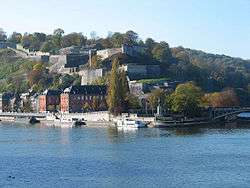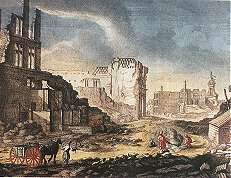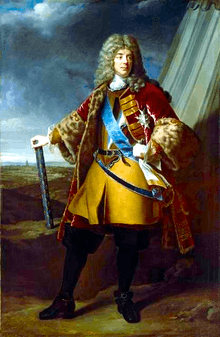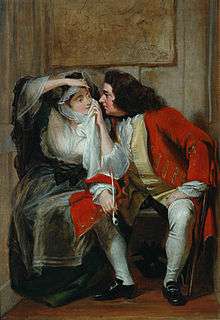Siege of Namur (1695)
| Siege of Namur (1695) | |||||||
|---|---|---|---|---|---|---|---|
| Part of the Nine Years' War | |||||||
 Siege of Namur (1695) by Jan van Huchtenburg. In the foreground King William III, dressed in grey, confers with Maximilian of Bavaria. | |||||||
| |||||||
| Belligerents | |||||||
|
|
Grand Alliance | ||||||
| Commanders and leaders | |||||||
|
|
| ||||||
| Strength | |||||||
| 13,000 | 58,000 [lower-alpha 2] | ||||||
| Casualties and losses | |||||||
| 8,000 | 12,000 | ||||||
The 1695 Siege of Namur or Second Siege of Namur took place during the Nine Years' War between 2 July to 4 September 1695. Its loss to the French in 1692 and recapture by the Grand Alliance in 1695 are often viewed as the defining events of the war and William III's most significant military success.[1]
Background

By 1694, the war in Flanders was at a stalemate. France had failed to force the Dutch Republic out of the war, despite victories at Steinkirk and Landen, and the capture of fortresses like Namur, Mons, Huy and Charleroi. The enormous costs of these offensives had exhausted the French economy, while crop failures in 1693 and 1694 caused widespread famine in France and Northern Italy; after 1693, Louis XIV assumed a largely defensive posture in Flanders.[2]
Helped by William's position as head of state for the Netherlands, England and Scotland, the Alliance had held together through four years of war, with losses that were damaging but not critical. In 1694, they recaptured towns like Huy and Diksmuide, and held a numerical advantage for the first time.
The 1690s marked the lowest point of the so-called Little Ice Age, a period of cold and wet weather affecting Europe in the second half of the 17th century. Famine in France and Italy was mirrored elsewhere, including Spain and Scotland, where the harvest failed in 1695, 1696, 1698 and 1699 and an estimated 5-15% of the population starved to death. [3] The Allies had also reached the limit of their resources and retaking Namur became the key objective for 1695.

This theatre is commonly referred to as Flanders but most campaigns took place in the Spanish Netherlands, a compact area 160 kilometres wide, the highest point only 100 metres above sea level, and dominated by canals and rivers. In the 17th century, goods and supplies were largely transported by water and the war was fought for control of rivers such as the Lys, Sambre and Meuse.[4]
This theatre is commonly referred to as Flanders but most campaigns took place in the Spanish Netherlands, a compact area 160 kilometres wide, the highest point only 100 metres above sea level, and dominated by canals and rivers. In the 17th century, goods and supplies were largely transported by water and the war was fought for control of rivers such as the Lys, Sambre and Meuse.[5]
Namur's location between the Sambre and Meuse made it a vital part of the "Barrier" system, a chain of fortresses in the Spanish Netherlands the Dutch viewed as essential for defence against French invasion. Its possession would be extremely advantageous to the side holding it in any peace negotiations.
The previous French commander in Flanders, Marshall Luxembourg, died in January 1695 and was replaced by the less talented Villeroi. French strategy for 1695 was to remain on the defensive and Boufflers spent April constructing entrenchments between the rivers Scheldt and Lys, from Coutrai/Kortrijk to Avelgem.[6] William marched on these in June with the bulk of the Allied force but secretly detached Frederick of Prussia to Namur. Once Frederick was in place on 2 July, William joined him; the Allies were now split into a besieging force of 58,000 at Namur and a field army of 102,000 under Prince Vaudémont to cover Villeroi.[7]
Siege
Namur was divided into the 'City,' with the residential and commercial areas, and the Citadel that controlled access to the Sambre and Meuse rivers. In 1692, the Dutch military engineer Menno van Coehoorn made the Citadel one of the strongest defensive points in Flanders, but the garrison was less than 5,000, many of them poorly-trained Spanish troops with low morale.[8] While the outer City fell relatively quickly, capturing the Citadel took the French over a month and they were nearly forced to withdraw by torrential rain and sickness. This was partly due to the terms negotiated for surrendering the City; van Coehoorn agreed not to fire on the City from the Citadel, in return for the French agreeing not to attack him from that direction, making it almost impregnable.[9]
After its capture, Namur's defences were significantly upgraded by Vauban, while Boufflers had a garrison of 13,000, making it a formidable challenge. During July, the Allies battered their way into the City, both sides incurring heavy casualties; by early August, half the French garrison had been lost.[10] On 3 August, Count Guiscard, Governor of Namur, surrendered the City to Maximilian of Bavaria and asked for a truce to allow the French to withdraw to the Citadel.[11] This was accepted and the siege resumed after six days.

Vaudémont's role was to keep his field army between Villeroi and Namur, while Villeroi tried to tempt him out of position by attacking Allied-held towns like Knokke and Beselare, now Zonnebeke.[lower-alpha 3] Vaudémont refused to be drawn since both sides knew the longer the siege went on, the more likely Namur was to fall. Villeroi's attempts to out-manoeuvre Vaudémont were unsuccessful, despite the capture of Diksmuide and Deinze in late July with 6,000 - 7,000 prisoners. The Bombardment of Brussels between 13-15 August also failed to divert the Allies, despite destroying large parts of the commercial centre; Constantijn Huygens, William's Secretary for Dutch affairs, visited Brussels on 11 September and recorded that the 'ruin caused...was horrible...and in many places, the houses reduced to rubble.'[12]
By mid-August, the Citadel remained largely intact, while Villeroi was making resupply much more difficult; the Allies were running out of time. Coehoorn and William now agreed a new approach;[lower-alpha 4] a battery of 200 guns was established in Namur city and on 21 August began a continuous 24 hour bombardment of the Citadel's lower defences. Boufflers later told Louis it was ‘the most prodigious artillery ever assembled' and by 26 August the Allies were ready to assault the Citadel. At midnight on 27th, Villeroi finally made contact with Vaudémont but his numerical advantage of 120,000 to 102,000 was offset by their strongly entrenched positions. Having failed to outflank the Allied lines, Villeroi retreated and William gave the order for a general assault.[13]
The assaults by the Allies were extremely bloody, that of 30 August alone costing 3,000 men in less than three hours but the defenders were eventually forced back to their final lines of defence. Count Guiscard, now commanding the key outwork of Fort Orange, told Boufflers on 2 September they could not repulse another attack and the garrison surrendered on 4 September, having suffered 8,000 casualties to the Allies 12,000.
Aftermath

The recapture of Namur was a major achievement for the Allies but Bouffler's energetic defence prevented them taking advantage of French weakness elsewhere, an achievement recognised by Louis promoting him to Field-Marshall.[14] Neither side was capable of mounting an offensive in 1696 and serious fighting came to an end, although Louis made one final demonstration prior to the signing of the Treaty of Ryswick in September 1697.

The Siege demonstrated the validity of Coehoorn's defensive ideas as explained in his 1685 book New Fortress Construction or Nieuwe Vestingbouw op een natte of lage horisont. In it he argued that passive reliance on fortifications was not enough in flat terrain like the Netherlands and that in trying to hold an entire town defenders risked losing it very quickly. Instead he advocated a strategy that balanced inner (Citadel) and outer (City) fortifications with an active defence using counter attacks to keep the besiegers off guard; Bouffler applied this idea, although he made the mistake of committing too many troops to the outer City.
The historian John Lynn summarised Boufflers' defence as follows; (He) demonstrated one could effectively win a campaign by losing a fortress, provided you pinned down and exhausted the besieging force in the process. He conducted a classic active defence, launching attacks by the garrison on the enemy's siege works, contesting every advance as best he could.[15] Boufflers would later conduct a similarly famous and effective defence of Lille in 1708.
Prisoners were normally exchanged as soon as possible, partly because neither side wanted the expense of having to feed them.[16] On this occasions, the French refused William's request for the return of the 6,000 - 7,000 troops captured at Diksmuide and Deinze due to a dispute over the terms of their surrender.[17] By now, shortage of manpower was a problem for all combatants; many of the rank and file were forcibly enlisted into French regiments and sent to fight in Italy or Catalonia.[18] Desertion from one army to another to receive a signing-on bonus was common, particularly as these were paid immediately and wages were often months in arrears. As recruiters were paid for each man they enlisted, several thousand additional soldiers represented significant profits for the French officers involved.[19] In retaliation, despite the garrison of Namur being allowed to surrender on terms, Boufflers was taken prisoner and released only when the remaining Allied prisoners had been returned in September.[20]
Legacy

While the Bombardment of Brussels failed to distract the Allies, some see it as marking the end of a period where the dominant form of warfare was taking or holding fortifications.[21] By demonstrating fortified towns could no longer resist the massive firepower available in modern warfare, it led to a move away from siege warfare and into the direct confrontations advocated by Marlborough and others in the War of the Spanish Succession.[22]
The assault by 3,000 British troops on the Terra Nova earthwork on 31 August spearheaded by 700 grenadiers is alleged to have been the inspiration for the song 'The British Grenadiers.'
The Siege and its aftermath is the centre of the novel Mother Ross; an Irish Amazon by GR Lloyd. This is an update of Daniel Defoe's original that purports to be the story of Christian 'Kit' Cavanagh alias Christian Davies, an Irish woman who enlisted in the British Army in 1693 disguised as a man and was present at the Siege.[23] Defoe claims to have met her in old age when she was a Chelsea Pensioner; it contains a number of factual errors but is an interesting and rare observation of the Siege from the rank and file.
Laurence Sterne's 1760 novel Tristram Shandy refers to a number of events from the Nine Years War, including Namur where Tristram's uncle Toby suffered an unspecified 'groin injury.' He and his trusted servant Corporal Trim build a replica of the battle in his garden which he shows to his fiancée Widow Wadman among others. The Widow tries to determine how serious Toby's injury is before committing to marriage but he avoids her questions by providing increasingly elaborate accounts of the siege.[24] This episode and Toby's reconstruction appear in the 2006 film A Cock and Bull Story.
Fourteen British regiments earned a battle honour for "Namur 1695" including the Grenadier, Coldstream and Scots Guards, the Royal Scots, the King's Own Scottish Borderers, the Royal Irish Regiment, the Royal Welch Fusiliers, the Royal Warwickshire Fusiliers, the Queen's Royal Regiment (West Surrey), the East Yorkshire Regiment and the West Yorkshire Regiment, the King's Own Royal Regiment and the King's Own Royal Border Regiment.
Notes
- ↑ Dates are per the Gregorian rather than the Julian calendar then used in Britain which was ten days behind.
- ↑ Other sources suggest 80,000.
- ↑ This area was devastated during the 1914-18 War and the original villages obliterated.
- ↑ Coehoorn was an extremely able engineer but his talent in siege operations is still debated; he was in charge at Namur due to casualties.
References
- ↑ Lenihan, Padraig (2011). "Namur Citadel, 1695: A Case Study in Allied Siege Tactics". War in History. 18 (3): 1. doi:10.1177/0968344511401296.
- ↑ Young, William (2004). International Politics and Warfare in the Age of Louis XIV. iUniverse. p. 229. ISBN 0595329926.
- ↑ Lynch, M (ed), White, I.D (author) (2011). Rural Settlement 1500-1770 in the Oxford Companion to Scottish History. OUP. pp. 542–543. ISBN 0199693056.
- ↑ Childs, John (1991). The Nine Years' War and the British Army, 1688-1697: The Operations in the Low Countries (2013 ed.). Manchester University Press. pp. 32–33. ISBN 0719089964.
- ↑ Childs, John (1991). The Nine Years' War and the British Army, 1688-1697: The Operations in the Low Countries (2013 ed.). Manchester University Press. pp. 32–33. ISBN 0719089964.
- ↑ Lynn, John (1999). The Wars of Louis XIV, 1667-1714 (Modern Wars In Perspective). Longman. p. 247. ISBN 0582056292.
- ↑ Hume, David (1848). The History of England 1609-1714. p. 609. Retrieved 28 February 2018.
- ↑ de la Colonie, Martin, Horsley, Walter (1904). The Chronicles of an Old Campaigner M. de la Colonie, 1692-1717 (2015 ed.). Scholars Choice. p. 16. ISBN 1296409791.
- ↑ de la Colonie, Martin, Horsley, Walter (1904). The Chronicles of an Old Campaigner M. de la Colonie, 1692-1717 (2015 ed.). Scholars Choice. p. 16. ISBN 1296409791.
- ↑ Lenihan, Padraig (2011). "Namur Citadel, 1695: A Case Study in Allied Siege Tactics". War in History. 18 (3): 10–11. doi:10.1177/0968344511401296.
- ↑ Bright, James Pierce (1836). A History of England;Volume III (2016 ed.). Palala Press. p. 294. ISBN 135856860X.
- ↑ Dekker, Rudolf M (2013). Family, Culture and Society in the Diary of Constantijn Huygens Jr, Secretary to Stadholder-King William of Orange. Brill. p. 50. ISBN 9004250948.
- ↑ Lenihan, Padraig (2011). "Namur Citadel, 1695: A Case Study in Allied Siege Tactics". War in History. 18 (3): 20–21. doi:10.1177/0968344511401296.
- ↑ Young, William (2004). International Politics and Warfare in the Age of Louis XIV. iUniverse. p. 230. ISBN 0595329926.
- ↑ Lynn, John (1999). The Wars of Louis XIV, 1667-1714 (Modern Wars In Perspective). Longman. pp. 248–249. ISBN 0582056292.
- ↑ Childs, John (1991). The Nine Years' War and the British Army, 1688-1697: The Operations in the Low Countries (2013 ed.). Manchester University Press. p. 37. ISBN 0719089964.
- ↑ Childs, John (1991). The Nine Years' War and the British Army, 1688-1697: The Operations in the Low Countries (2013 ed.). Manchester University Press. p. 40. ISBN 0719089964.
- ↑ Bright, James Pierce (1836). A History of England;Volume III (2016 ed.). Palala Press. p. 295. ISBN 135856860X. Retrieved 26 February 2018.
- ↑ Manning, Roger (2006). An Apprenticeship in Arms; the Origins of the British Army 1585-1701. A good overview of how the recruitment system worked in this period: OUP. pp. 326 passim. ISBN 0199261490.
- ↑ Stapleton, John M (2007). "Prelude to Rijswijk: William III, Louis XIV, and the Strange Case of Marshal Boufflers". The Western Society of French History. 35. Retrieved 15 May 2018.
- ↑ Childs, John (1991). The Nine Years' War and the British Army, 1688-1697: The Operations in the Low Countries (2013 ed.). Manchester University Press. p. 2. ISBN 0719089964.
- ↑ Dekker, Rudolf M (2013). Family, Culture and Society in the Diary of Constantijn Huygens Jr, Secretary to Stadholder-King William of Orange. Brill. p. 45. ISBN 9004250948.
- ↑ Lloyd, GR (2012). Mother Ross; an Irish Amazon (Rewrite of the Daniel Defoe book ed.). AuthorHouseUK. p. 66. ISBN 147721934X.
- ↑ Brewer 1898, Shandy.
Sources
- Childs, John; The Nine Years' War and the British Army (Manchester University Press, 1991);
- Childs, John; The British Army of William III, 1689-1702 (Manchester University Press, 1990);
- Lenihan, Padraig; Namur Citadel, 1695: A Case Study in Allied Siege Tactics (War in History, 2011)
- Lynn, John; The Wars of Louis XIV, 1667-1714 (Longman, 1999);
- Young, William; International Politics and Warfare in the Age of Louis XIV (iUniverse, 2004);